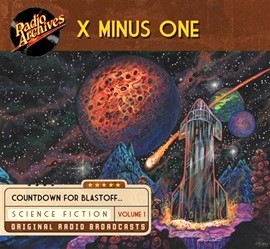
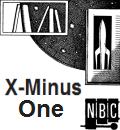 X Minus One (1955-58) aired “No Contact” on April 24, 1955 as its 1st episode.
X Minus One (1955-58) aired “No Contact” on April 24, 1955 as its 1st episode.
Consensus among radio historians has set the number of X Minus One episodes at 126 (counting roughly half a dozen rebroadcasts), with 119 in circulation. The show was cancelled on January 9, 1958 following its 126th episode, and was the longest running adult SF show in radio history. It was a revival if you will, of Dimension X, which ran from April 1950 through September 1951, airing 50 episodes. The first 15 X Minus One shows were remakes of Dimension X adaptations of stories first appearing in Astounding Science Fiction, but after that the remaining shows were dramatizations of stories from Galaxy. For those trying to keep a chronology of the important adult SF series’ straight, here’s the breakdown:
2000 Plus — March 15, 1950
Dimension X — April 8, 1950
X Minus One — April 24, 1955
Exploring Tomorrow — December 4, 1957
The two writers responsible for bringing both Dimension X and X Minus One to life on radio were Ernest Kinoy (April 1, 1925–November 10, 2014) and George Lefferts (June 18, 1921–April 3, 2018). While they would adapt stories previously printed in the SF magazines Astounding SF and Galaxy, each would write original stories from time to time under their own bylines, or, in the case of this week’s episode, they both contributed to the original story and Lefferts would work up the final script.
Dimension X aired “No Contact” twice, first on April 29, 1950 and then again on October 28, 1950 such was its popularity. This X Minus One remake, while the same script, has cleaner, updated production values and also provides us the opportunity to update information brought to our attention recently on George Lefferts, by his daughter. First, I would like to reprise in large part the introduction to an episode we ran in 2015 (9 years ago) outlining some of the highlights of Lefferts’ career, many of which I fear the science fiction audience outside of radio may not be aware.
Until recently I, too, knew little of the man outside of his connection to Dimension X and X Minus One, but was amazed at how stellar his career has been to this point. His credits and awards are far too numerous to mention here, but here’s a sample of what I found at the Dramatists Guild of America site: “[George Lefferts] is a Writer/Producer/Journalist/Composer, five-time Emmy Award winner for: “Best Drama” [producer, “Teacher, Teacher” Hallmark Hall of Fame, NBC]; “Best Special Series,” [writer/producer/director “Specials for Women,” NBC]; “Best Miniseries” [producer, “Benjamin Franklin,” CBS]; “Best Daytime Program” [writer, “One Life to Live,” ABC]; and “Best Daytime Drama” [writer, “Never Say Goodbye,” CBS]. He won two Golden Globe Awards for “SOS Andrea Doria” and NBC’s “Specials for Women.”
“He won the New England Press Association award for ‘Best Weekly Newspaper Column in America’ for two consecutive years for his columns in The New York Observer.
“He won The Cine Golden Eagle Award for Best Industrial Film” for “Moonflights & Medicine” [writer, for Merck]; two Golden Globe Awards for “NBC Specials for Women” and “SOS Andrea Doria” and The National Media Award for “Specials for Women,” [NBC, Margaret Mead called this series a groundbreaker for the Women’s Movement in America]; and The Albert Lasker Medical Award for “Hospital Emergency,” [NBC].
“He was nominated for The Christopher Award for Outstanding Writing for “Never Say Goodbye,” [CBS] and he won The Producers’ Guild Award for his original film series “Breaking Point,” directed by Sydney Pollack, starring Robert Redford, Hume Cronyn, Jessica Tandy. Lillian Gish, Walter Pedgeon and John Cassavetes. [ABC].
“He wrote and produced the film The Living End [NBC]. [Variety wrote: “…a work of art. The writing by George Lefferts was so pure it was well-nigh perfect.”] He also produced and wrote “The Smithsonian Institution Specials” [CBS] and served as Executive Producer for Time-Life Films, CBS, David Wolper Productions, NBC, and ABC.”
As if this wasn’t enough, Lefferts wrote scripts for the radio version of Ripley’s Believe it or Not, studied poetry with W. H. Auden, and served four years in the Army during World War II. And the list goes on. For more I recommend his comparatively brief wikipedia page, though it adds information not included in the Dramatists Guild piece.
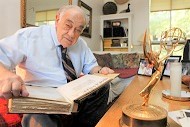 One would think that with all of his accomplishments through the decades and with much written and known about George Lefferts that it would be no great feat to find out the simple fact of when the man was born, but this has turned out to be a great mystery. After coming up empty after semi-exhaustive internet searches of at least a dozen sites mentioning him or his work, there was no information regarding his date of birth–and thus his age. However, through two clues appearing in the article from which I snagged Lefferts’ photo at left, I believe him to be either 94 or 95 (depending on his exact birth date). The website, nj.com (the initials standing for New Jersey), did an article on Old Time Radio dated October 2011 and stated that Lefferts was at that time 90. One need only to count backwards to arrive at his birth year being either 1920 or 1921 (again depending on whatever his exact birth date was). Why his date of birth is never given anywhere–at least at any of the dozen or so internet sites I found material on him–is indeed puzzling. Mystery, secrecy, and the unknown thus surround George Lefferts’ date of birth.
One would think that with all of his accomplishments through the decades and with much written and known about George Lefferts that it would be no great feat to find out the simple fact of when the man was born, but this has turned out to be a great mystery. After coming up empty after semi-exhaustive internet searches of at least a dozen sites mentioning him or his work, there was no information regarding his date of birth–and thus his age. However, through two clues appearing in the article from which I snagged Lefferts’ photo at left, I believe him to be either 94 or 95 (depending on his exact birth date). The website, nj.com (the initials standing for New Jersey), did an article on Old Time Radio dated October 2011 and stated that Lefferts was at that time 90. One need only to count backwards to arrive at his birth year being either 1920 or 1921 (again depending on whatever his exact birth date was). Why his date of birth is never given anywhere–at least at any of the dozen or so internet sites I found material on him–is indeed puzzling. Mystery, secrecy, and the unknown thus surround George Lefferts’ date of birth.
This mystery involving George Lefferts’ birth and death dates was solved (at least from our perspective) when I received, late in the evening of May 31, 2024, an email from George Lefferts’ daughter, Lauren (Lefferts) Taylor (M.A., M.S., L.C.S.W. Senior Lecturer, Columbia University School of Social Work). During her research for an audio piece about her father’s transition from radio to TV she ran across one of our X Minus One episodes from 2015 her father had written, and noticed our trouble with his birth date. She then thoughtfully emailed us, apprising us of the missing dates of her sadly now deceased father. To wit and as given near the top of this page: George Lefferts was born on June 18, 1921 and died on April 3, 2018. Please note that the date of death given on his wikipedia page (see link above) is incorrect, stating that George Lefferts died on April 18, 2018. Hopefully before long someone will correct this embarrassing error to reflect the accurate date of death as April 3, 2018. After a full life, the multi-talented, award winning author, journalist, producer, and composer whose limitless talent knew no bounds, deserves at least to have his date of death accurately given for the record. I wish to thank Lauren Taylor for taking the time to inform us of her father’s correct date of death, thus supplying another brick in the historical wall where science fiction and Old Time (Golden Age) Radio met.
 Now, as to this week’s OTR episode, we pay homage to George Lefferts by offering the X Minus One upgraded broadcast of “No Contact.” The story takes place when mankind has explored the moon and nearer planets, but attempts to travel farther into space have proved disastrous. Five exploratory missions have encountered an invisible barrier preventing any outward expansion…and none of them have returned. Transmissions of any kind cannot penetrate the strange barrier, so the fate of the first five missions is unknown. Destroyed? Flung into deep space? Alive in some unfathomable limbo? “No Contact” tells the tense story of the next mission’s attempt to penetrate the invisible barrier, for Man has discovered a new planet and desperately wishes to visit it for the usual reasons (lifeforms, habitability, etc.). Sit back and enjoy this classic radio drama, co-created by Ernest Kinoy and George Lefferts, with the final script written by Lefferts.
Now, as to this week’s OTR episode, we pay homage to George Lefferts by offering the X Minus One upgraded broadcast of “No Contact.” The story takes place when mankind has explored the moon and nearer planets, but attempts to travel farther into space have proved disastrous. Five exploratory missions have encountered an invisible barrier preventing any outward expansion…and none of them have returned. Transmissions of any kind cannot penetrate the strange barrier, so the fate of the first five missions is unknown. Destroyed? Flung into deep space? Alive in some unfathomable limbo? “No Contact” tells the tense story of the next mission’s attempt to penetrate the invisible barrier, for Man has discovered a new planet and desperately wishes to visit it for the usual reasons (lifeforms, habitability, etc.). Sit back and enjoy this classic radio drama, co-created by Ernest Kinoy and George Lefferts, with the final script written by Lefferts.
(The linked CD cover at top includes this episode and 11 others on 6 CDs.)
Play Time: 27.58
{Broadcast on a Sunday evening in late April of 1955, the neighborhood gang hit the nearby newsstand after school the next day in search of more of their favorite magazine fare. Fantastic Universe (1953-60) was part of the mini-explosion of new science fiction magazines appearing in the early 1950s. It lasted longer than most of them, finishing with a commendable 69 issues before calling it a day, though it drew many of the top names in the field, authors the likes of Judith Merril, Walter M. Miller, Jr., Algis Budrys, Lester del Rey, Theodore Sturgeon, and Poul Anderson to name a few. It was a monthly in 1955. The Magazine of Fantasy & Science Fiction (1949-present), known informally as F&SF, began as a quarterly at the end of 1949, switched to a bi-monthly in 1951, and by the middle of 1952 enjoyed monthly publication for almost 40 years, at which time it combined its October/November issues dropping the issues per year to 11, the schedule it would maintain until 2009. It then dropped to a bi-monthly schedule through 2023. It quickly became regarded as the “literary” SF magazine, inviting writers to explore new themes, or to revisit more traditional story material in new ways. This approach caught on quickly and the magazine flourished in due course. 1955 was its third full year as a monthly. Science Fiction Stories (1955-60) was the culmination of a long series of magazines begun in 1939 combining first into a single publication, then changing names any number of times until in its final incarnation it settled on the title shown below. It featured old-fashioned science fiction made popular in the 1930s by a mix of older talent offset by a number of writers who would make a name for themselves in the years to come. Among the older set there was Clifford D. Simak, Fritz Leiber, Eric Frank Russell, and Raymond F. Jones, with the relatively newer crop of soon-to-be stars finding their voices, among them Robert Silverberg, Gordon R. Dickson, Marion Zimmer Bradley, and James Blish, among others. Save for 3 or 4 issues in 1958 and 1959, Science Fiction Stories was a bi-monthly.}
[Left: Fantastic Universe, 4/55 – Center: F&SF, 4/55 – Right: Science Fiction Stories, 5/55]
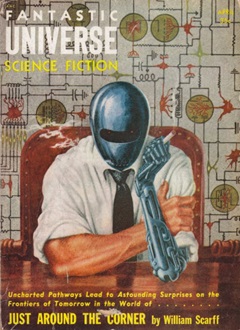
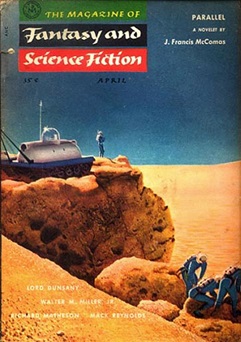
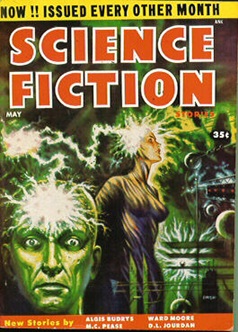
To view the entire list of weekly Old Time Radio episodes at Tangent Online, click here.